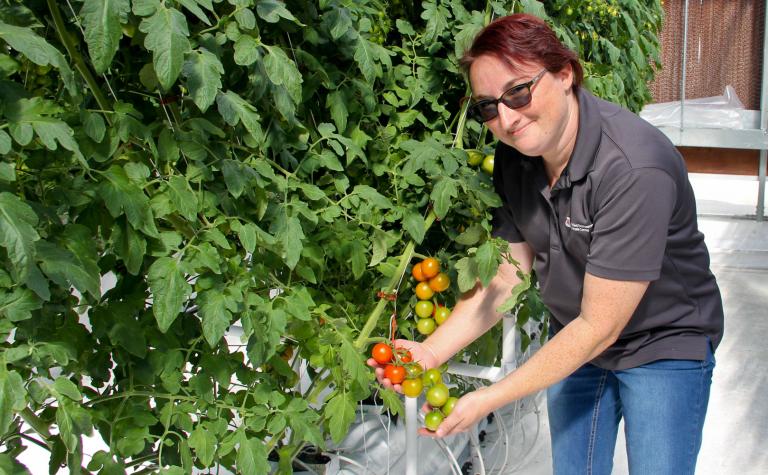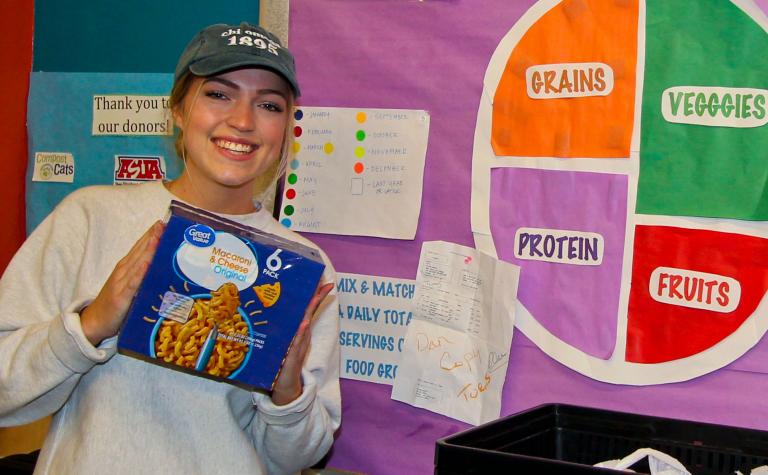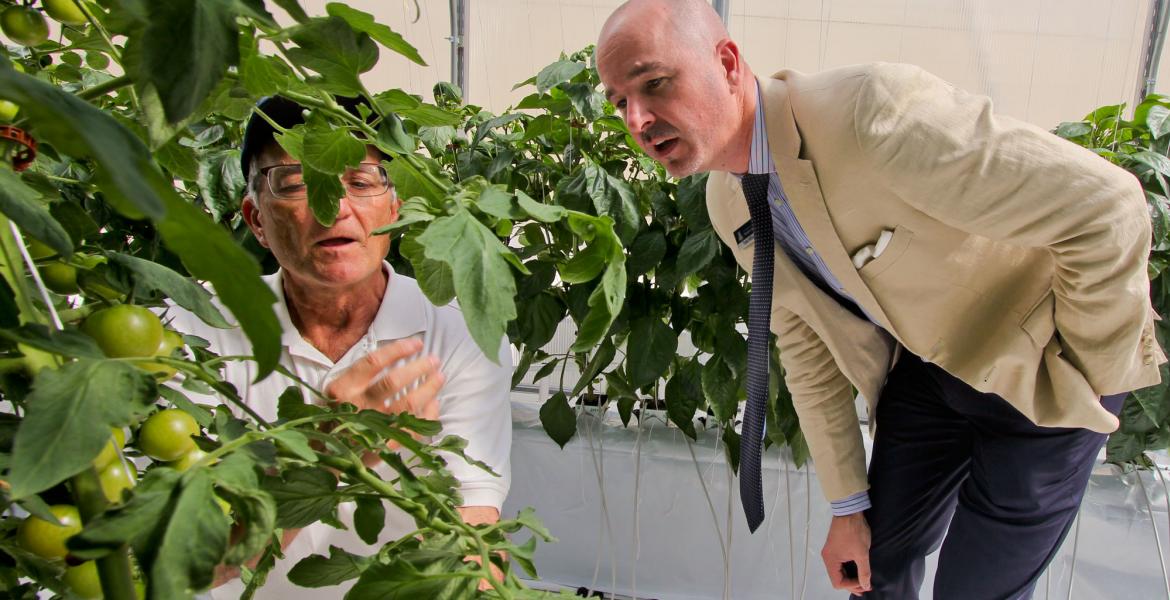Rooftop Greenhouse Teaches, Nourishes and Empowers Students
Twice a week in the basement of the Student Union Memorial Center, about 500 students, faculty and staff pick up free groceries at the University of Arizona Campus Pantry.
Twice a week on the roof of the student union, UA students and future commercial growers harvest cucumbers, tomatoes and bell peppers from the rooftop greenhouse and send the vegetables down to the campus pantry. This student-designed, and mostly student-run, controlled-environment facility is the first rooftop campus greenhouse in the nation that can produce food year-round, with 10x the productivity of an outdoor garden.
“We harvest on the same days the campus pantry does distribution and bring the food right down, so the produce is super fresh,” said Stacy Tollefson, the project and production manager for the greenhouse and a professor of practice in the Department of Biosystems Engineering, as well as an expert veggie grower for the UA’s nationally recognized Controlled Environment Agriculture educational program.
The Seed of an Idea
When Todd Millay first became director of the Arizona Student Unions in December 2016, he was excited to see there was a small outdoor garden on the roof being run by staff. When he heard about the campus pantry, which was serving about 30 to 40 people every few weeks, he offered pantry volunteers a central campus location in the student union, but noticed they weren’t receiving many fresh produce donations. The potential for connection seemed clear.
“Why don’t we just make a better garden on the roof and send the food down?” he thought. “And maybe instead of student union employees figuring out how to do this, we could ask students how to build it.”

Millay and some student union colleagues partnered with the Office of Student Engagement and launched a four-month competition. Twenty-five groups of five students were given a hypothetical $50,000 budget to design a cost-effective, productive and sustainable system to grow fresh produce for the campus pantry. Coca Cola, Shamrock Farms, the UA Student Union, the UA Student Services Fees Grant and the UA Green Funds Grant helped finance the competition and the eventual greenhouse.
The winning team, composed of four College of Engineering students and one College of Agriculture and Life Sciences student, proposed a 750-square-foot temperature-controlled greenhouse that would grow tomatoes, cucumbers and bell peppers. Design advice from Gene Giacomelli, a professor of biosystems engineering and the former director of the Controlled Environment Agriculture program, combined with donations from companies like Autogrow, Formflex, Grodan, Wadsworth Control Systems and Polytex Inc., led to the greenhouse’s construction in 2018.
The Tech Behind the Tomatoes
The greenhouse is temperature-controlled and could yield produce year-round, but the team harvests for nine months and takes the summer to prepare for new student recruits and start afresh. In that nine months, Tollefson expects the greenhouse to yield 3,000 pounds of cucumbers, 800 pounds of cherry tomatoes, 1,200 pounds of sliced tomatoes and 250 pounds of bell peppers.
The plants don’t get their nutrients from soil but from two large tanks full of nutrient solution with just the right mix of nitrogen, phosphorous, potassium and other plant nutrients. Any solution that isn’t absorbed by the greenhouse’s four rows of plants is recirculated back into the tanks, revitalized and fed right back to the plants.
“We’re saving tons of water with this recirculating hydroponic system, because we’re only losing maybe five percent to evaporation, and we’re saving tons of nutrients,” Tollefson said.

In addition to conserving water and nutrients, the recirculation system ensures that no fertilizer water is discharged into the environment. Another hi-tech feature is that the greenhouse climate and irrigation control systems are connected to the internet: The greenhouse team can log in and monitor the nutrient solution for pH, electrical conductivity and temperature from their phones.
Efforts Bearing Fruit
Tollefson, who has a doctoral degree in agricultural and biosystems engineering, said working at the greenhouse has been an excellent learning experience even for her -- this is the first time she has grown hydroponic tomatoes while recirculating the nutrient solution, so both she and the students are learning how to manage plant nutrition more efficiently. Student interns are learning hydroponic cultivation techniques and greenhouse management techniques that translate to valuable career skills.
“There’s a tremendous demand out in the industry for people who know how to operate these greenhouses because of the recent interest in locally grown and urban agriculture,” Giacomelli said.
Tollefson oversees two interns -- plant sciences major Chris Patzke and veterinary science major Tyler Rodriquez -- and full-time greenhouse manager Quinn Waltz, a senior majoring in agricultural technology management.
The greenhouse team makes frequent visits to the greenhouse to check on the hydroponic system; care for the plants and monitor the environmental conditions; and harvest, weigh and deliver the crops to the campus pantry. The idea is to make sure everything is running smoothly -- and it certainly is. This fall, the cucumber plants were growing about two feet a week, and the tomato plants about 18 inches. The tomatoes and bell peppers are just starting to ripen, but they’re already delivering about 50 pounds of cucumbers to the pantry each week.
“We keep the conditions just right,” Patzke said. “Happy plants grow really fast.”
The students in the greenhouse say they love knowing their work is making a difference in the Wildcat community.
“It’s inspiring and humbling to know we are the first ones working on this project,” Waltz said. “We are setting the foundation for future students who want to be a part of something that impacts others, and to learn about how and where their food comes from.”
The UA Campus Pantry has food distribution days from noon to 7 p.m. on Wednesdays and 11 a.m. to 3 p.m. during the academic year. Tours of the Rooftop Garden are available on Wednesday mornings at 10 a.m. and can be signed up for at the Arizona Student Unions information desk.


